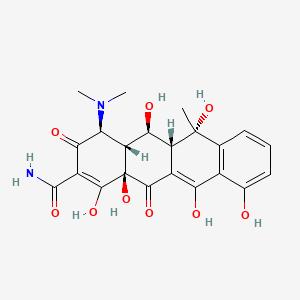| Jin X et al. |
The effect of Cu(2+) chelation on the direct photolysis of oxytetracycline: A study assisted by spectroscopy analysis and DFT calculation. |
2016 |
Environ. Pollut. |
pmid:27155101
|
| Tan B et al. |
A versatile fluorescent biosensor based on target-responsive graphene oxide hydrogel for antibiotic detection. |
2016 |
Biosens Bioelectron |
pmid:27132000
|
| Çelebi H et al. |
Removals of non-analogous OTC and BaP in AMCBR with and without primary substrate. |
2016 |
Environ Technol |
pmid:26670775
|
| Aristilde L et al. |
Enhanced interlayer trapping of a tetracycline antibiotic within montmorillonite layers in the presence of Ca and Mg. |
2016 |
J Colloid Interface Sci |
pmid:26613334
|
| Xu S et al. |
Novel dual ligand co-functionalized fluorescent gold nanoclusters as a versatile probe for sensitive analysis of Hg(2+) and oxytetracycline. |
2016 |
Anal Bioanal Chem |
pmid:26597915
|
| Yan Z et al. |
A sensitive electrochemical aptasensor for multiplex antibiotics detection based on high-capacity magnetic hollow porous nanotracers coupling exonuclease-assisted cascade target recycling. |
2016 |
Biosens Bioelectron |
pmid:26594886
|
| Hundt M et al. |
The Effect of Water Hardness on Mortality of Zebrafish (Danio rerio) During Exposure to Oxytetracycline. |
2016 |
Bull Environ Contam Toxicol |
pmid:26585646
|
| Chen M et al. |
An electrochemical aptasensor for multiplex antibiotics detection based on metal ions doped nanoscale MOFs as signal tracers and RecJ exonuclease-assisted targets recycling amplification. |
2016 |
Talanta |
pmid:27769495
|
| Santaeufemia S et al. |
Bioremediation of oxytetracycline in seawater by living and dead biomass of the microalga Phaeodactylum tricornutum. |
2016 |
J. Hazard. Mater. |
pmid:27565856
|
| Cao J et al. |
Improvement of the soil nitrogen content and maize growth by earthworms and arbuscular mycorrhizal fungi in soils polluted by oxytetracycline. |
2016 |
Sci. Total Environ. |
pmid:27496075
|
| RodrÃguez-Dorado R et al. |
Oxytetracycline recovery from aqueous media using computationally designed molecularly imprinted polymers. |
2016 |
Anal Bioanal Chem |
pmid:27488280
|
| Romero T et al. |
Short communication: Drug residues in goat milk after prophylactic use of antibiotics in intravaginal sponges for estrus synchronization. |
2016 |
J. Dairy Sci. |
pmid:26585470
|
| Lees P et al. |
Comparison of standardised versus non-standardised methods for testing the in vitro potency of oxytetracycline against Mannheimia haemolytica and Pasteurella multocida. |
2016 |
Vet. J. |
pmid:27938710
|
| Li S et al. |
A platform for the development of novel biosensors by configuring allosteric transcription factor recognition with amplified luminescent proximity homogeneous assays. |
2016 |
Chem. Commun. (Camb.) |
pmid:27869274
|
| Sun J et al. |
Effects of oxytetracycline on the abundance and community structure of nitrogen-fixing bacteria during cattle manure composting. |
2016 |
Bioresour. Technol. |
pmid:27318157
|
| Attaie R et al. |
Applicability of Screening Tests for Oxytetracycline in the Milk of Three Breeds of Goats. |
2016 |
J. Food Prot. |
pmid:27296606
|
| ÄuriÄić D et al. |
Comparison of Intrauterine Antibiotics versus Ozone Medical Use in Sheep with Retained Placenta and Following Obstetric Assistance. |
2016 |
Reprod. Domest. Anim. |
pmid:27287827
|
| Chen H et al. |
Rapid synthesis of Ti-MCM-41 by microwave-assisted hydrothermal method towards photocatalytic degradation of oxytetracycline. |
2016 |
J Environ Sci (China) |
pmid:27266304
|
| Gharred T et al. |
Assessment of the individual and mixture toxicity of cadmium, copper and oxytetracycline, on the embryo-larval development of the sea urchin Paracentrotus lividus. |
2016 |
Environ Sci Pollut Res Int |
pmid:27259955
|
| Ziółkowski H et al. |
Metal ion-oxytetracycline pharmacokinetic interactions after oral co-administration in broiler chickens. |
2016 |
Poult. Sci. |
pmid:27190106
|
